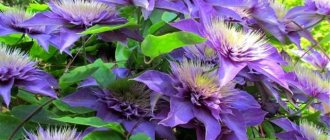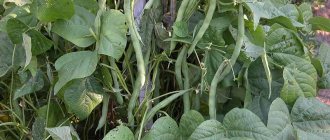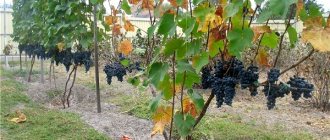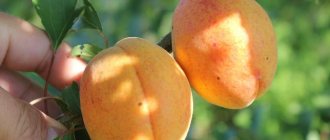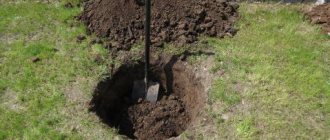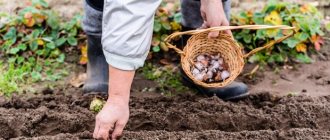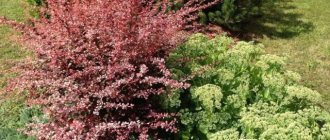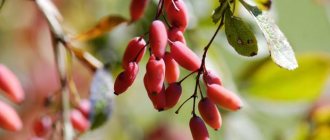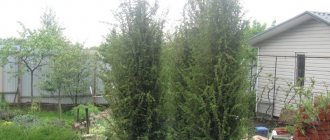Botanical description
Barberry
The plant is a shrub and belongs to the genus Barberry (Berberis) of the family of the same name. A little more than 170 species of this plant are known, which in the wild are widespread in Asia and Europe (not above the temperate zone), and in North America. Several varieties of barberry are cultivated in gardens.
Common barberry is popular among gardeners in our climate zone. This is a bush, branched and spreading, reaching 2.5-3 m in height. Thin flexible branches are covered with brown bark and equipped with spines, up to 2.5 cm long. The roots are creeping, mostly superficial.
The shrub is well leafy. The leaves are elongated oval, 3.5-4 cm long. The edge of the leaf blade is jagged-serrate. They sit on branches in bunches of 3-5 pieces. They are painted light green.
Common barberry flowers are collected in 20-22 pieces in a brush. The flowers are bright yellow, up to 8 mm in size. The length of the flower brush reaches 6-7 cm. Barberry blooms in May.
The plant produces edible fruits, which are berries. They have a spindle-shaped shape, reach a length of more than 1 cm, and hang on a branch in bunches. The color is bright red. The taste of the berries is sour and refreshing. The harvest ripens in September.
Inside the fruit there are small seeds (the weight of a thousand plant seeds is no more than 12 g).
Diseases and pests
Pests such as barberry sawfly, barberry aphid or flower moth can harm this shrub. A bush infected with aphids begins to wrinkle and dry out its leaf blades. The moth poses a great danger to those species that have edible fruits, because it feeds on them. To exterminate aphids, use a solution of laundry soap (300 grams of substance per bucket of water). To destroy sawfly caterpillars, as well as moths, it is necessary to treat the bush with a 1–3% chlorophos solution.
In most cases, these shrubs are subject to infection by fungal diseases, such as rust, leaf spot, powdery mildew, bacteriosis or wilt. In a bush infected with powdery mildew, a whitish powdery coating appears on the surface of the leaf blades, berries and stems. Closer to autumn, cleistothecia appear in areas of the plant that are affected by the disease, and the fungus will survive wintering well in them. In order to get rid of such a disease, you should treat it with a solution of colloidal sulfur (1%). Those stems that are very damaged must be cut off and destroyed. As a rule, rust appears on those bushes that grow near cereal plants. On an infected specimen, orange spots appear on the front side of the leaves, while red convex pads form on the back side. In case of severe infection, the leaf plates dry out and fall off. You can get rid of this disease by treating it with a special solution, which is carried out 3 times. To do this, use a solution of Bordeaux mixture or colloidal sulfur (1%). The first treatment is carried out immediately after all the buds open and the leaves grow, and subsequent treatments are carried out with a break of 20 days.
When infected with leaf spot, spots of various shapes appear on the leaf blades, due to which the plant loses its decorative appearance. To get rid of the disease, a solution of copper oxychloride is used (30 to 40 grams per bucket of water). Treatment should be carried out before the barberry blooms and after flowering has ended. In a bush infected with wilt, the leaves and stems become limp and dry out. In this case, wilting begins on one side, and then gradually spreads throughout the plant. To prevent the disease from affecting the entire bush, it is necessary to cut off the infected stems in a timely manner. Also, at the initial stage of wilting development, copper oxychloride or Bordeaux mixture will help get rid of it. For preventive purposes in the spring, the bushes should be sprayed with Bordeaux mixture. When infected with bacteriosis (bacterial cancer), tumors and cracks appear on the bush, and it begins to grow. If bacteriosis has affected only the upper part of the stem, then it must be cut off, while capturing healthy tissue. However, if the cancer appears on the lower part of the stem, which is located next to the trunk, then the entire bush will become infected. Infected areas must be cut off and destroyed, then the entire bush must be treated with Bordeaux mixture or another product that contains copper.
Benefits of barberry and application
The fruits, foliage and bark of the plant contain alkaloid compounds, organic acids, saccharides, essential oils, and vitamins. The following substances are recognized as particularly useful and valuable:
- berberine (a substance with a choleretic effect);
- oxyacanthin;
- leontine;
- acids – tartaric, malic, citric;
- vitamin C (its amount in barberry berries is higher than in lemon fruits);
- retinol;
- pectin;
- glucose and fructose.
In folk and official medicine:
- to increase and strengthen immunity (useful to use during colds and viral infections);
- as a choleretic and diuretic (for diseases of the kidneys and urinary tract);
- as a sedative for nervous disorders;
- anti-inflammatory;
- lowering blood pressure;
- The drink speeds up metabolism and also cleanses blood vessels of cholesterol deposits.
Official medicine uses this plant in the homeopathic preparation Berberis, which is included in therapy for diseases of the genitourinary system.
Attention! Unripe barberry fruits contain high concentrations of alkaloids, so they are not eaten. During pregnancy, chronic liver diseases, and a tendency to allergies, use barberry with caution, only after consultation with a specialist.
In cooking
Fresh and dried berries of the plant have long been used in cooking. Barberries are used to season meat dishes (the famous Uzbek pilaf is unthinkable without these berries), lentil soups and other legumes. They are used to make jam, marshmallows and marmalade, and are used to flavor sweets and alcoholic beverages. Edible fruits can even be pickled.
Properties of barberry
Useful properties of barberry
Many species and varieties of barberry are grown as garden decorations. However, common barberry is, as a rule, grown to produce fruits from which compotes, liqueurs, marinades, pastilles, jelly, syrups, jams and jellies are prepared. Pickled barberry fruits are used in Armenian cuisine, so they are served with lamb, fried vegetables or rice.
In edible species, the fruits contain tartaric, malic and citric acids, and the leaf blades contain vitamins E and C, as well as carotenoids and mineral salts. The fruits can lower blood pressure, fight psoriasis, tone the body, destroy various infections in the intestines, stop bleeding, and also prevent the growth of lamblia, yeast and other parasites.
All parts of barberry have medicinal properties. Only ripe berries should be collected, because unripe ones contain poison. The berries are dried in a shaded place, and the temperature should not exceed 50 degrees. After this, they are poured into paper bags or cardboard boxes, where they are stored for no more than 3 years.
The plant has anti-inflammatory, choleretic, analgesic, antipyretic, antispasmodic, antitumor, hemostatic, and antibacterial effects. A decoction of the roots relieves inflammation of the gallbladder and promotes the outflow of bile. A decoction of leaf plates is used for various forms of hepatitis, digestive disorders, inflammatory processes in the gastrointestinal tract, diseases of the liver, gall bladder and ducts. A decoction of the bark will help with chronic pancreatitis. The juice of the fruit has a mild laxative effect and improves appetite. Ripe fruits mixed with honey can improve the body's immune system after radiation exposure. A decoction of the roots is used to wash sore eyes, wounds, and areas of the epidermis affected by eczema, and it is also used for lotions, compresses and rubs for radiculitis, arthritis, rheumatism, leg muscle spasms and osteochondrosis.
Contraindications
Medicines prepared using barberry cannot be used to treat children under 12 years of age, people with individual intolerance, as well as those suffering from complex forms of hepatitis, cirrhosis of the liver and cholelithiasis. And also during pregnancy, during postpartum or menopausal bleeding. Remember that unripe fruits contain poison!
When is the right time to plant barberry?
Barberry tolerates transplantation well. If you buy a seedling with a closed root system, you can plant it at any warm time of the year. It is advisable to plant seedlings with an open root system in autumn or spring.
In the regions of our country (south, middle zone, Moscow region), it is best to plant barberry in the fall. This time is favorable, as the summer heat subsides and there is enough rainfall.
Planting barberry bushes in open ground is carried out 40-50 days before the onset of stable frosts. In the middle zone and Moscow region, the optimal time occurs in September; in the south of our country, barberry can be transplanted in October.
Important! Planting in the northern regions and Siberia is carried out in the spring, so that the young plant has time to take root during the summer and get stronger before the arrival of winter.
Seedling care
The main operations for caring for barberry bushes are:
- loosening the soil, facilitating access of oxygen to the roots of the plant;
- watering in dry weather, weeding and weed removal;
- pruning weak and diseased branches, forming a bush;
- feeding
In the first 2 years after planting, the seedling should be covered with burlap for the winter to protect it from the cold. Mature bushes can tolerate negative temperatures quite easily. If the winter is harsh and frost damages the branches, they are pruned in spring to healthy buds.
Barberry responds very well to mulching
Barberry is a fast-growing shrub that is recommended to be pruned regularly in spring or fall. This will not only remove the skeletal branches located in the central part of the bush, which lead to its excessive thickening, but also give it a beautiful decorative shape with the help of pruning. The first pruning is done a year after planting, removing half or two-thirds of the branch growth. The best time to give a neat shape to a barberry hedge is June and August.
Attention! Some varieties of barberry have sharp thorns, so when caring for them you should protect your hands with strong gloves. Regular watering (once every 4-7 days) is required only when the soil dries out in dry hot weather and for recently planted plants.
Site selection and soil preparation
Despite its unpretentiousness, barberry does not like excess moisture in the soil. For cultivation, choose an area without close groundwater and in an elevated place.
It is preferable to place the shrub in an open sunny place. It will grow well in lace shade, but the color of the foliage will not be as bright.
The scheme for planting seedlings depends on the size of the adult plant and the purpose of planting. For tall varieties from which edible berries are harvested, it is necessary to leave
the distance between plants is at least 3 m. Decorative compact bushes are placed at intervals of 1-1.5 m. For a dense hedge, planting is dense - 2-3 seedlings per 1 m.
2 weeks before planting, the soil on the site is dug up, removing weeds. Loose and fertile soil with a slightly acidic reaction is suitable for growing barberry. If the soil is heavy, up to 10 kg of coarse river sand per 1 square meter is added for digging. m. Acidic soil is corrected by adding dolomite flour (up to 350 g per 1 sq. m) and wood ash (up to 400 g per 1 sq. m). Alkaline soil is acidified by adding peat, up to 6 kg per square area.
Varieties
Despite the variety of types and varieties of barberry, each specimen is individual and beautiful. When choosing a plant variety, you should be guided by your preferences. To obtain edible fruits, certain types of shrubs are chosen, while others are chosen to decorate the garden.
Common barberry is a tall type of barberry (up to 3 meters). The fruits are large (1.5 cm), edible, numerous. The common barberry has many varieties:
- Albo-Variegata - the bush has decorative foliage with white specks or stripes,
- Aureo-Marginata - bush 1.5 m high, leaves with a golden or silvery edge,
- Atropurpurea is a shrub with red or purple leaves that does not shed its leaves for a long time.
- Asperma is a bush with dark red, seedless fruits that are easy to process.
Thunberg barberry is a deciduous shrub with a height of 50 cm to 1 m. It is considered one of the beautiful ornamental species. A special feature of this species are branches that extend horizontally. Young shoots have a cream or red color, and with age they acquire a brown or red-brown tint. The forms of this species are quite diverse, differing in the number of flowers, the color of foliage, shoots, and other parameters. Gardeners prefer varieties: Golden Ring; Red Pilar; Orange; Kornik.
photo: © ballyrobertgardens.com
Ottawa barberry is a hybrid that appeared in the process of crossing common barberry and Thunberg barberry. It has absorbed the most striking properties from these representatives of the genus. This species is frost-resistant and grows quite quickly.
Planting barberry in autumn - instructions
Before immersing in the soil, it is useful to soak the seedlings for an hour or two in a solution of Kornevin or Heteroauxin, diluting the drug according to the instructions.
- In the prepared area, planting holes are dug, measuring 30 by 30 cm and up to 50 cm deep. Drainage in the form of broken bricks, crushed stone or pebbles is poured onto the bottom. Drainage layer 4-5 cm.
- To plant the seedling, a nutrient mixture is prepared: turf soil is mixed with sand and humus in equal parts. Add 120 g of superphosphate and 80 g of potassium sulfate to a bucket of this mixture.
- The hole is filled one third with prepared soil. The seedling is placed in the center of the hole, the roots are carefully straightened. If it was in a pot, there is no need to destroy the root ball.
- Holding the barberry bush, its roots are evenly covered with soil, compacting it with your palms. The root collar of the seedling remains on the surface of the ground.
- Water generously with water and mulch with humus, tree bark, and sawdust.
After planting, the barberry crown is shortened to 5-6 buds. This measure will help the plant take root better.
Preparation and rules for planting young seedlings
Planting and further care in open ground depends on the quality of barberry seedlings. It is not recommended for a novice gardener to pursue exotics.
It is better to give preference to proven varieties of ordinary barberry. When purchasing, you should make sure that there are no dry leaves or shoots on the seedling. The root system must be elastic.
The plant prefers soils with a neutral pH.
If the soil on the site is acidic, it is necessary to add wood ash or slaked lime in advance.
Heavy soils drain. To do this, crushed stone or broken brick is poured into the bottom of the planting hole.
The size of one pit is 40 by 40 cm.
After planting, the bushes are watered and mulched abundantly. It is recommended to trim off extended branches.
Planting a single plant
The distance from other plants is at least one and a half meters.
The depth of the hole should be slightly larger than the earthen ball of the seedling.
After immersion, the roots in the planting hole are carefully laid out.
It is better to sprinkle the plant with a nutritious substrate consisting of peat, turf soil and humus.
You can’t bury the growing point, as this slows down the development of the bushes.
Planting a hedge
Barberry does not suffer from baldness of the lower part, so the green fences are especially lush.
Planting barberry depends on how thick the hedge is planned to be.
In order for the bushes to grow in a dense wall, it is necessary to plant 4 seedlings per linear meter.
Selection of neighbors for barberry
The shrub gets along well with most garden plants. It pairs well with flowering perennials such as daylilies, roses and chrysanthemums. Peony and barberry are often used together in landscape design.
In alpine hills, shrubs are planted next to thuja, juniper, heather and boxwood.
In mixborders, barberry's neighbors are hostas, echinaceas, sedums, bergenias and miscanthuses. Dogwood and barberry are good to alternate in a hedge.
Care
The plant will not cause much trouble to the gardener. When caring for barberry, it is important to remember that it does not like excess moisture. When grown in the middle zone, the shrub has enough natural rainfall. Only during the period of flowering and filling of berries, it needs weekly watering.
Mulching the soil will help reduce the need for watering and curb the growth of weeds. Gradually rotting, it provides additional nutrition to the plant. The following mulch is used: chopped straw, hay, wood shavings and bark, fallen leaves.
Some gardeners grow a garden under meadows - they sow lawn grasses under the trees, which are periodically mowed. This garden looks neat, but the lawn requires watering, fertilizing and mowing. Ready-made sets of cereal grasses and white clover are used for sowing.
The fertilizers applied during planting will be enough for the barberry to last for a whole year. From the following spring, nitrogen fertilizers are applied to each bush - 20 g of urea is dissolved in 10 liters of water. You can use a solution of chicken manure in a concentration of 1 to 15.
In August, it is useful to feed the plants with phosphorus-potassium fertilizers. You can use wood ash and bone meal, 100 g per 1 square meter. m.
On a note. Barberry, grown as a hedge and subjected to regular pruning, needs increased feeding. It is fed with nitrogen fertilizers twice a season - in spring and mid-summer. At the end of summer, phosphorus-potassium fertilizers are applied to the soil (15 g of superphosphate and 10 g of potassium sulfate per bush).
Varieties and varieties of barberry
In the wild, the crop is a shrub reaching two meters in height. The arched branches of the plant are studded with thorns.
Leaves grow from the base of the thorns. Barberry blooms in May–June.
The oblong red berries ripen in September. They contain many vitamins and microelements. In their natural environment, bushes grow along rivers, at the foot of mountains, and on the edges.
Decorative barberry looks great both during the flowering and fruiting periods. Elegant autumn foliage sets off yellowed trees and bushes.
About ten species of shrubs grow on Russian territory, but breeders are creating new unique and hardy varieties.
Today, tall plants, dwarfs and semi-creeping shrubs are available for sale.
Common barberry is more common than others. The plant takes root well and grows quickly. The flowers have a honey aroma.
Gardeners prefer bushes with purple leaves, which look impressive as a hedge.
Popular varieties:
The low-growing shrub has white-variegated foliage.
In shaded areas it loses its decorative effect.
The flowering period occurs at the end of May.
The fruits ripen by the end of September and remain on the bush until frost occurs. The berries can be used in cooking.
Aureo-marginata is a medium-sized plant.
The leaves have a golden hue.
By early autumn they turn bright red.
Yellow-red flowers form on the bush.
The berries ripen in September.
Atropupurea - the bush reaches two meters in height. The leaf color is purple.
The branches grow by 25 cm per year.
Small flowers are yellow in color.
The plant produces a bountiful harvest every year. The variety is drought resistant.
Common barberry is suitable for hedges in the conditions of Siberia and the Far East.
Thunberg's barberry came from the mountain slopes of China and Japan. This species is compact and spherical.
Other advantages include special decorativeness and resistance to fungal diseases.
Popular varieties:
Lutin rouge. This variety of Thunberg barberry is suitable for small areas. The foliage is tinted red throughout the summer. The fruits do not fall off in the winter, which gives the bush additional decorativeness. The variety can withstand cold temperatures down to -30˚C.
Pink Queen. The height of the bush does not exceed one and a half meters. The spreading crown and pinkish leaves allow this variety to be planted in solitaire plantings. In the shade the leaves turn brown. The variety tolerates pruning well.
Admiration. The height of the plant barely exceeds half a meter. Shoots grow slowly. Red leaves are edged with a light stripe. Bright red berries remain on the bush until mid-winter.
Thunberg barberry “Kornita” is most often used for landscaping parks and courtyards. The spreading, dark-colored shrub is drought-resistant and winter-hardy.
Trimming
Barberry has a lush, fast-growing crown. To get a bush with a beautiful shape and keep it healthy, the plant must be trimmed regularly.
Barberry pruning is carried out in early spring (March-April), before the active movement of sap along the branches begins. They work with well-sharpened pruning shears and loppers, not forgetting to cover the wounds on the trunk with garden varnish.
Remove all unnecessary and weak branches, cutting them close to the trunk, leaving no stumps. The bush's branches grow upward; in its natural form the crown resembles a broom or broom. You can change the shape to a cup-shaped one by bending some branches to the sides and fixing them with stretch marks.
Barberries can be given geometric shapes using plywood templates. Rectangular hedges are the most popular among gardeners.
The growth growing from the roots is regularly removed.
Important! The gardener should be aware of the sharp spines of the plant and protect his hands with gloves.
Features of autumn pruning of barberry
As a rule, this procedure is performed in spring and autumn. It is necessary in order to select thin, dry or damaged branches. It is better not to leave underdeveloped branches for the winter. The fact is that they will take away excess energy from the plant at a time when it needs additional energy.
It is recommended to wear thick gloves when pruning barberry, as the bush is very prickly. Also in autumn and spring, shaping can be done in order to give the plant the required shape.
Barberry propagation
You can get new plant specimens in several ways:
- seeds;
- dividing the bush;
- cuttings;
- layering.
Seeds
It takes a long time to propagate barberry by seeds. But, if you want to grow a large number of seedlings for a hedge, spending a little money, this option is preferable.
Seeds are removed from fully ripe berries. They are washed and pickled in a pink solution of potassium permanganate for 30 minutes. The seeds, dried to a free-flowing state, are sown in open ground in October - November.
The bed (school) is prepared in a sunny place, carefully digging and leveling the surface. The seeds are immersed 7-8 mm into the soil, at a distance of 2-3 cm from each other. The top of the soil is sprinkled with fallen leaves, which are removed in the spring.
The seedlings are cared for in the standard way: watered and weeded. Young barberry is transplanted to a new location in the fall. Seedlings must be covered before cold weather; young shoots are tender and sensitive to frost.
Another option for seed propagation of barberry is sowing seeds for seedlings at home or in a greenhouse. In December, the seeds are placed in damp sand or a rag and buried in the snow in the garden or put in the refrigerator for 3 months.
In March, the seeds are sown in prepared peat-humus-sand soil. Keep the crops on window sills or in a heated greenhouse at a temperature of +18 +20 degrees. Seedlings are transplanted into the ground in May.
Root shoots or layering
Mature barberry bushes form a lot of growth coming from the roots. It is very simple to select a suitable cutting and dig it out of the soil, cutting off the root connecting it to the mother plant with a shovel. The operation is best performed in autumn or late summer.
It is necessary to ensure that after digging up the shoots the roots of an adult bush are not exposed.
Advice. A couple of days before the separation of barberry shoots, the bush is watered abundantly. This will make it easier for the plant to survive the operation.
Immediately after digging, new seedlings from cuttings are transferred to the selected area and planted. They are cared for in the standard way - watered and covered for the winter.
Dividing a barberry bush
When it’s time to move the bush to a new area, the bush is divided. The carefully dug rhizome is cleared of soil and divided into parts with pruners or a saw. At least 3-4 growth buds should be preserved on each division. The root sections are sprinkled with ash or covered with garden varnish.
The cuttings are planted in new areas, watering and mulching the soil. Barberry is transplanted in the fall, 1.5 months before the onset of frost.
Cuttings
Gardeners recommend using lignified cuttings to propagate barberry; they take root better.
Instructions:
- Cuttings are cut from branches, 2 years old. They are brown in color and dense to the touch. Harvesting time is October.
- The size of the branches for propagation is 16-18 cm and the diameter is at least 5 mm. The bottom cut is made at an acute angle.
- All leaves from the cuttings are torn off and the planting material is placed in the cellar until spring or dug in on the site.
- In the spring, the branches are rooted in a greenhouse or in a bed under a greenhouse. The cuttings are buried halfway into the soil and at an angle.
- Caring for plantings consists of regular watering and spraying the branches in the heat.
By autumn, the cuttings should give growth in the above-ground part and take good roots underground. They are transplanted to a permanent place next year.
How to propagate
There are four ways to propagate this prickly plant: cuttings, seeds, layering and dividing the bush. Let's look at everything in more detail.
Barberry seedlings can be obtained in different ways
Cuttings
The current year's shoots are used as cuttings. The branches should be 20-25 cm long. The cuttings are planted in a garden bed in open ground or in pots. They must be watered and covered for a while with covering material (from the sun). By the way, in order for the shoots to take root better, it is recommended to soak them for 12 hours in a growth stimulant solution before planting. Cuttings can be planted in a permanent place after two years. For two years, they must be watered, weeded, and the soil loosened. A seedling obtained from cuttings will produce a harvest in the third year.
Seeds
To propagate barberry with seeds, you first need to collect the ripened berries. The seed is a seed that is located inside the berry. It is separated from the pulp and dried on newspaper. Before planting, it is recommended to treat the seed material with a weak solution of potassium permanganate. Sow seeds in the fall, but before the onset of negative temperatures. Seedlings can be planted in permanent places in the second year. At the time of fruiting, barberry obtained from seeds enters its third year.
By layering
A quick and easy way to propagate barberry. Annual shoots of the plant are tilted to the ground, pressed down and covered with earth. If you root barberry in the fall, then in the fall of next year the cuttings can be cut off from the mother bush and planted in other places. This barberry takes root well. It begins to bear fruit in the third year.
Dividing the bush
Perhaps the easiest way to propagate this useful shrub. The bushes are carefully dug up and divided into several parts. From one adult bush you can get several units of planting material. It is important to delete old branches. They will get sick and prevent young shoots from developing. The seedlings obtained from division also enter the time of fruiting in the third year. The survival rate is usually excellent.
In general, barberry shrubs are easy to grow and propagate. Even novice gardeners can cope with this with great success. The most important thing is to follow the simple rules described in the article. Then your garden will sparkle with the colors of this unusual plant.
When and how to replant barberry
A plant can remain in one place for more than 15 years. But, over time, the soil under it is depleted, despite fertilizing. Diseases accumulate in the soil. Therefore, it is recommended to move the bushes to another place every 10 years.
It is correct to replant a barberry bush in late summer or early autumn. Before the operation, the plant is subjected to severe pruning (removing a third of the length of all shoots) and abundant watering.
If dividing the bush is not planned, the barberry is dug in with a pitchfork from all sides and carefully removed from the soil. It is convenient to move the bush to a new place by placing it on a piece of tarpaulin or film.
The planting hole is dug according to the size of the earthen clod. After transplanting, water and mulch abundantly.
Disease Prevention
If not properly cared for, barberry bushes are susceptible to fungal diseases: Powdery mildew covers all parts of the plant with a whitish coating. At the end of summer, formations appear in infected areas where the fungus overwinters. Severely affected areas are cut out and burned. In milder cases, you can fight the disease with a 1% solution of colloidal sulfur.
Rust appears as orange spots on the upper side of the leaves, and raised brown pads on the underside of the leaves of the seedling. With deep damage, the leaves of the bush dry out and fall off. Rust can be defeated by treating the bushes three times with a 1% solution of colloidal sulfur or Bordeaux mixture. Treatment of plants should begin as soon as leaves appear and then regularly after 3 weeks. Barberry seedlings can be prevented from spotting by treating them with a solution of copper oxychloride before and after flowering.
Bacterial cancer (bacteriosis) appears on the shoots of the plant with cracks and growths. It’s not scary if the cancer has affected the tip of the shoot - just remove the affected area, capturing a slightly healthy one. But if the cancer has affected the part of the plant adjacent to the trunk, the bush is doomed. Infected areas must be cut out and burned, and the bush should be treated with a preparation containing copper.
Rules for transplanting barberry to a new place
Transplantation is accompanied by stress and injury to the plant. The gardener is recommended to prepare the bush for moving in advance and care for it after it is transplanted.
Selecting a location
When choosing when it is best to replant a plant, the gardener must also choose a place for planting. It must be remembered that the bush:
- Does not tolerate stagnation of moisture in the soil. The distance between the bush and groundwater must be at least 1.5 m. If this rule is not followed, the root system of the plant begins to rot. If possible, barberry is planted on a hill; an artificial embankment is acceptable. You can plant the plant on southern slopes.
- Loves well-lit places. The shrub will grow in the shade, but in order for barberry to bear fruit, it needs light. Green varieties of shrubs can be planted in partial shade. The bush should be protected from direct sunlight at midday. You can plant barberry near a taller plant that will cast a shadow on the bush at the right time of day.
- Requires a lot of free space. The bush must be planted at a distance of at least 2 m from other plants. As barberry grows, it occupies a large area. The shrub should not be planted next to fences, the wall of a building, etc.
- Does not tolerate acidic soil. Before replanting the plant, it is necessary to treat the soil with a deoxidizing agent. It is necessary to check the pH, which should not be less than 6 or more than 7. The most favorable types of soil for barberry bushes are considered to be loam and chernozem.
We recommend that you read How to prepare blackberries for winter in the Moscow region
Barberries should not be planted next to windows. The plant attracts a large number of insects that will enter the room.
Favorable months for transplantation
If the gardener decides to replant the shrub in the spring, you need to wait until the temperature reaches above zero. In which month to plant depends on the region. For example, residents of the Moscow region carry out work in the first half of April; in the southern regions, the middle or end of March may be a favorable time.
When transplanting shrubs in the autumn months, you need to focus on the climatic conditions of your region.
September and the first half of October are favorable for central Russia - during this period the ground has not yet frozen. To find out when and how to transplant barberry to a new place in the fall, you can use the gardener’s lunar calendar for the current year.
Subtleties of the procedure
2-3 days before transplanting, the bushes need daily abundant watering. If the plant has received enough moisture, less damage will be caused to the root system. To work, you must choose a cloudy day. If the transplant is planned in sunny weather, you should work early in the morning or late in the evening.
Planting barberry in a new place consists of two stages. The first is preparing the hole. It must be prepared 10-15 days before gardening. It is permissible to dig a hole 2-3 days before transplanting. The size of the hole depends on the age of the transplanted bush: the older it is, the deeper and wider it should be. If you plan to create a hedge, you need to dig a trench at least 0.5 m deep.
At the next stage, a drainage layer of sawdust or dry leaves is poured onto the bottom of the hole. Then you need to sprinkle a small amount of wood ash, which will help protect the bush from fungi. After this, a mixture of compost, humus and soil from the area where the barberry grows is added.
When the hole is ready, you need to carefully dig out the bush. You can use a tarp to carry the plant to avoid injury. The lump of earth with which the bush was dug up must be saturated with stimulating substances (“Epin”).
We recommend that you familiarize yourself with Honeysuckle Gourmand
Before transplanting, it is necessary to cut off part of the rhizome. With a large number of shoots, the load on the root system increases. To prevent the plant from starting to rot, root cuttings are treated with Kornevin or other similar preparations.
After placing the bush in the hole, water it at the roots. Then you need to carefully add soil. At the final stage, the soil at the roots is compacted. To better retain moisture, lay a layer of peat or compost on the soil.
Pest protection after transplantation
When transplanted, the plant weakens and becomes vulnerable to various pests - caterpillars, aphids, etc. If the owner does not intend to use the fruits of the bush, you can protect the barberry from any insects using chemicals, such as Eleksar.
If barberry berries are used for food, it is advisable to use folk remedies. You can eliminate pests by spraying the bush with garlic infusion. It is necessary to ensure that fungi do not appear on the bush - the plant has practically no immunity to them.
Barberry pruning
After moving, the transplanted bush should be pruned. This can be done not only in spring, but also in autumn, since during this period the movement of juices stops. The lower branches are often pruned. The plant does not always need crown formation. During autumn pruning, the bush must be rejuvenated by removing old branches. In some cases, the upper parts of young growths must be partially removed.
How to fertilize a plant after replanting
The plant does not need feeding immediately after transplantation, since the fertilizer was placed in the hole before gardening. You need to start feeding the bush after a year. Before fertilizing the soil, it is necessary to remove weeds and loosen the soil.
The following types of fertilizers are used for fertilizing:
- Superphosphate. The fertilizer is used for fruit plants. The bush needs to be watered twice a year: after flowering and 2-3 weeks before winter.
- Urea. The first time feeding is carried out in the spring. Urea should be used no more than once every 4 years.
- Bird or cow droppings. It is necessary to fertilize the soil with droppings 2 times a year: in early spring and late autumn.
We recommend reading: Preparing raspberries for winter in Siberia
Watering and loosening
Transplanted plants need daily watering. However, you should not use more than 0.5 liters of water per plant. You need to pour the liquid under the root without touching the crown. You can stop daily watering 5-6 weeks after transplanting. During periods of drought, the soil must be moistened at least once every 10 days.
In the first 2-3 weeks, the soil in which the shrub was planted should not be loosened - the plant should gain a foothold in the new soil. But already a month after planting, the soil should be loosened at least once a week to saturate the soil with oxygen.
Do I need to cover it for the winter?
If the transplanted bush is under 5 years old, with the onset of the first frost its roots must be covered with sawdust, peat or fallen leaves. At the first frost, shelters are installed, which can only be removed in the first half of March.
